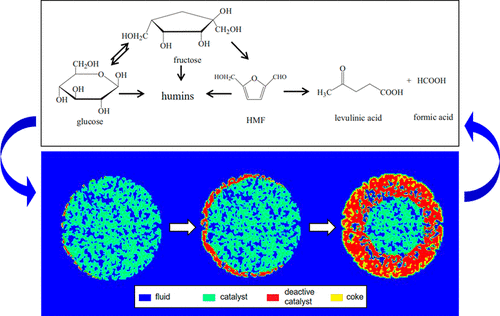当前位置:
X-MOL 学术
›
Ind. Eng. Chem. Res.
›
论文详情
Our official English website, www.x-mol.net, welcomes your feedback! (Note: you will need to create a separate account there.)
Coking Prediction in Catalytic Glucose Conversion to Levulinic Acid Using Improved Lattice Boltzmann Model
Industrial & Engineering Chemistry Research ( IF 4.2 ) Pub Date : 2020-09-08 , DOI: 10.1021/acs.iecr.0c03635 Siwei Liu 1, 2, 3, 4 , Xiangqian Wei 5 , Weitao Sun 5 , Chenguang Wang 1, 2, 3 , Wenzhi Li 5 , Longlong Ma 1, 2, 3 , Qiying Liu 1, 2, 3
Industrial & Engineering Chemistry Research ( IF 4.2 ) Pub Date : 2020-09-08 , DOI: 10.1021/acs.iecr.0c03635 Siwei Liu 1, 2, 3, 4 , Xiangqian Wei 5 , Weitao Sun 5 , Chenguang Wang 1, 2, 3 , Wenzhi Li 5 , Longlong Ma 1, 2, 3 , Qiying Liu 1, 2, 3
Affiliation

|
Considering process efficiency, flow and coking are important aspects in biomass and its derivatives for catalytic conversion to value-added products. However, these investigations are scarcely involved due to the very complex reaction environment and coupling mass transfer and coking process. To better understanding the coking process in glucose catalytic conversion to levulinic acid (LA), a particle-scale model based on the lattice Boltzmann model (LBM) was proposed. In this model, a coking model based on te volume of pixels scheme was developed to simulate the coking deactivation process, and a zeolite permeability model based on the gray LBM scheme was developed for fluid permeation inside shaped zeolite. The model was validated by both analytical and experimental data. The effects of temperature, particle porosity, and coking on catalyst deactivation, product yield, and selectivity were investigated. The numerical results indicated that the deactivation time of shaped zeolite peaked at the particle porosity of 0.20 and increased as the operating temperature decreased. Glucose conversion, LA yield, and humins yield increased with the increase of particle porosity and operating temperature. The opposite trend of the intermediate 5-hydroxymethylfurfural (HMF) was found when the temperature and porosity were increased. The results also showed that the LA selectivity and the yield ratio of LA to humins peaked at a porosity of 0.45 and a reaction temperature of 180 °C.
中文翻译:

改进的格子玻尔兹曼模型的催化葡萄糖转化为戊酸的焦化预测
考虑到过程效率,流量和焦化是生物质及其衍生物中催化转化为增值产品的重要方面。然而,由于非常复杂的反应环境以及传质和焦化过程的耦合,这些研究很少涉及。为了更好地理解葡萄糖催化转化为乙酰丙酸(LA)的焦化过程,提出了基于晶格玻尔兹曼模型(LBM)的粒度模型。在该模型中,开发了基于像素体积方案的焦化模型来模拟焦化失活过程,并开发了基于灰色LBM方案的沸石渗透性模型以用于成形沸石内部的流体渗透。该模型已通过分析和实验数据验证。温度,颗粒孔隙率,研究了焦化对催化剂失活,产物收率和选择性的影响。数值结果表明,成形沸石的失活时间在颗粒孔隙率为0.20时达到峰值,并随着工作温度的降低而增加。葡萄糖转化率,LA收率和腐殖质收率随颗粒孔隙率和操作温度的增加而增加。当温度和孔隙率增加时,发现了中间体5-羟甲基糠醛(HMF)的相反趋势。结果还表明,LA的选择性和LA与腐殖质的收率之比在孔隙率为0.45和反应温度为180℃时达到峰值。并随着工作温度的降低而升高。葡萄糖转化率,LA收率和腐殖质收率随颗粒孔隙率和操作温度的增加而增加。当温度和孔隙率增加时,发现了中间体5-羟甲基糠醛(HMF)的相反趋势。结果还表明,LA的选择性和LA与腐殖质的收率之比在孔隙率为0.45和反应温度为180℃时达到峰值。并随着工作温度的降低而升高。葡萄糖转化率,LA收率和腐殖质收率随颗粒孔隙率和操作温度的增加而增加。当温度和孔隙率增加时,发现了中间体5-羟甲基糠醛(HMF)的相反趋势。结果还表明,LA的选择性和LA与腐殖质的收率之比在孔隙率为0.45和反应温度为180℃时达到峰值。
更新日期:2020-09-30
中文翻译:

改进的格子玻尔兹曼模型的催化葡萄糖转化为戊酸的焦化预测
考虑到过程效率,流量和焦化是生物质及其衍生物中催化转化为增值产品的重要方面。然而,由于非常复杂的反应环境以及传质和焦化过程的耦合,这些研究很少涉及。为了更好地理解葡萄糖催化转化为乙酰丙酸(LA)的焦化过程,提出了基于晶格玻尔兹曼模型(LBM)的粒度模型。在该模型中,开发了基于像素体积方案的焦化模型来模拟焦化失活过程,并开发了基于灰色LBM方案的沸石渗透性模型以用于成形沸石内部的流体渗透。该模型已通过分析和实验数据验证。温度,颗粒孔隙率,研究了焦化对催化剂失活,产物收率和选择性的影响。数值结果表明,成形沸石的失活时间在颗粒孔隙率为0.20时达到峰值,并随着工作温度的降低而增加。葡萄糖转化率,LA收率和腐殖质收率随颗粒孔隙率和操作温度的增加而增加。当温度和孔隙率增加时,发现了中间体5-羟甲基糠醛(HMF)的相反趋势。结果还表明,LA的选择性和LA与腐殖质的收率之比在孔隙率为0.45和反应温度为180℃时达到峰值。并随着工作温度的降低而升高。葡萄糖转化率,LA收率和腐殖质收率随颗粒孔隙率和操作温度的增加而增加。当温度和孔隙率增加时,发现了中间体5-羟甲基糠醛(HMF)的相反趋势。结果还表明,LA的选择性和LA与腐殖质的收率之比在孔隙率为0.45和反应温度为180℃时达到峰值。并随着工作温度的降低而升高。葡萄糖转化率,LA收率和腐殖质收率随颗粒孔隙率和操作温度的增加而增加。当温度和孔隙率增加时,发现了中间体5-羟甲基糠醛(HMF)的相反趋势。结果还表明,LA的选择性和LA与腐殖质的收率之比在孔隙率为0.45和反应温度为180℃时达到峰值。



























 京公网安备 11010802027423号
京公网安备 11010802027423号